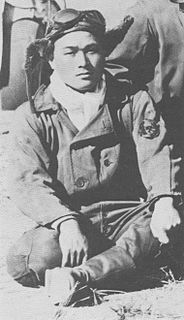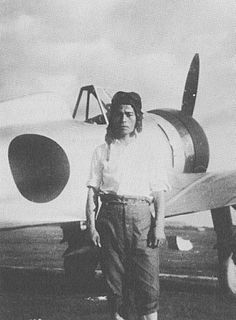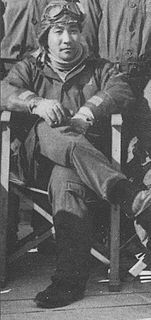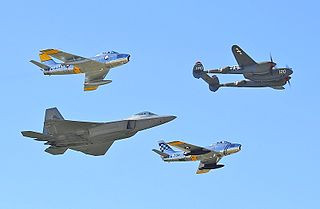I-29, code-named Matsu, was a B1 type submarine of the Imperial Japanese Navy used during World War II on two secret missions with Germany. She was sunk while returning from the second mission.

The 25th Air Flotilla was a combat aviation unit of the Imperial Japanese Navy (IJN) during the Pacific Campaign of World War II. The flotilla, mainly consisting of land-based bombers, fighters, and reconnaissance aircraft, reported to the IJN's 11th Air Fleet. As originally organized, the flotilla's core units were the 4th Naval Air Group, Tainan Naval Air Group, and Yokohama Naval Air Group. The 4th flew bombers, the Tainan fighters, and the Yokohama reconnaissance aircraft.

Yoshinao Kodaira was an officer and ace fighter pilot in the Imperial Japanese Navy during World War II. Participating in many of the Pacific War battles and campaigns as a member of several units, including the fighter units of the aircraft carriers Shōkaku and Chiyoda, Kodaira was officially credited with destroying 13 enemy aircraft. After the war, he served with the Japan Air Self-Defense Force. In 2008, Tsubasa-kai, the veterans' organization of the JASDF, reported his death on its website.

Ichirō Yamamoto was an ace fighter pilot in the Imperial Japanese Navy during World War II. Participating in many of the Pacific War battles and campaigns as a member of several units, Yamamoto was officially credited with destroying 11 enemy aircraft. He was killed in aerial combat with American carrier fighters on June 19, 1944 during the Battle of the Philippine Sea.

Kenji Okabe was an ace fighter pilot in the Imperial Japanese Navy (IJN) during World War II. Participating in many of the Pacific War battles and campaigns as a member of several units, Okabe was officially credited with destroying 15 enemy aircraft. Okabe was credited with shooting down eight enemy aircraft on 8 May 1942 during the Battle of the Coral Sea, the IJN's official record for the number of aircraft destroyed in a single encounter. He is famous for his strong opposition to the kamikaze attacks, rare in IJN at the time. Okabe survived the war.

Yoshimi Minami was an ace fighter pilot in the Imperial Japanese Navy (IJN) during World War II. Participating in many of the Pacific War battles and campaigns as a member of several units, Minami was officially credited with destroying 15 enemy aircraft. He was killed in November 1944 attempting to crash his aircraft into enemy ships off Leyte as a participant in Kamikaze operations.

The Tainan Air Group was a fighter aircraft and airbase garrison unit of the Imperial Japanese Navy (IJN) during the Pacific campaign of World War II. The flying portion of the unit was heavily involved in many of the major campaigns and battles of the first year of the war. The exploits of the unit were widely publicized in the Japanese media at the time, at least in part because the unit spawned more aces than any other fighter unit in the IJN. Several of the unit's aces were among the IJN's top scorers, and included Hiroyoshi Nishizawa, Saburō Sakai, Junichi Sasai, Watari Handa, Masaaki Shimakawa, and Toshio Ōta.

Mitsugu Mori was an officer and ace fighter pilot in the Imperial Japanese Navy (IJN) during the January 28 Incident, the Second Sino-Japanese War, and the Pacific theater of World War II. As a member of the 12th Air Group during the Second Sino-Japanese War, Mori was officially credited with destroying four Chinese aircraft in aerial combat.

Yoshio Fukui was an officer and ace fighter pilot in the Imperial Japanese Navy (IJN) during the Second Sino-Japanese War and the Pacific theater of World War II. In aerial combat over China and the Pacific, he was officially credited with destroying 11 enemy aircraft with four probables. Fukui survived World War II.

Masaichi Kondō was an officer and ace fighter pilot in the Imperial Japanese Navy (IJN) during the Second Sino-Japanese War and the Pacific theater of World War II. In aerial combat over China and the Pacific, he was officially credited with destroying 13 enemy aircraft. Kondō survived World War II.

Hatsuo Hidaka was an officer and ace fighter pilot in the Imperial Japanese Navy (IJN) during the Second Sino-Japanese War and the Pacific theater of World War II. Graduating from Kasumigaura Naval Air Group in November 1934, Hidaka joined the first division, the 15th Air Group bound to Hankou as a Petty Officer, 3rd Class on November 1, 1937 bound to Hankou with the flight time of 1,040 hours. During May and July 1943, Hidaka was stationed at Truk Island and often flew to Rabaul airfield on New Britain.

Satoru Ono (1915-2001) was an officer and ace fighter pilot in the Imperial Japanese Navy (IJN) during the Second Sino-Japanese War and the Pacific theater of World War II. In aerial combat over China, the Pacific, and Japan, he was officially credited with destroying eight enemy aircraft. From 1943 until the end of World War II, Ono specialized in nocturnal interceptions of enemy bombers engaged in nighttime bombing raids. Ono survived World War II and died in 2001.

Chitoshi Isozaki was an officer and ace fighter pilot in the Imperial Japanese Navy (IJN) during the Second Sino-Japanese War and the Pacific theater of World War II. In aerial combat over China, the Pacific, and Japan, he was officially credited with destroying twelve enemy aircraft. Isozaki survived World War II.

Yoshio Shiga was an officer, ace fighter pilot, and leader in the Imperial Japanese Navy (IJN) during the Second Sino-Japanese War and the Pacific theater of World War II. At the December 1941 Attack on Pearl Harbor, Shiga led one of the aircraft carrier Kaga's fighter divisions during the first strike on American forces on Oahu. The number of his Zero fighter was AII-105. Shiga continued as a fighter division commander on Kaga until April 1942.

Nangō Mochifumi was an officer and ace fighter pilot in the Imperial Japanese Navy (IJN) during the Second Sino-Japanese War. In action in the war, Nangō was officially credited with destroying eight enemy aircraft.

Tadashi Kaneko was an officer, ace fighter pilot, and leader in the Imperial Japanese Navy (IJN) during the Second Sino-Japanese War and the Pacific theater of World War II. Before his death in combat, Kaneko was officially credited with destroying eight enemy aircraft.

Kazuo Tsunoda was an officer and ace fighter pilot in the Imperial Japanese Navy (IJN) during the Second Sino-Japanese War and Pacific Campaign of World War II. In his combat career, Tsunoda was officially credited with destroying nine enemy aircraft.

Kenichi Abe was an ace fighter pilot in the Imperial Japanese Navy (IJN) during the Pacific theater of World War II. In aerial combat over the Pacific, he was officially credited with five victories, plus five jointly, and two probables.

Vice Admiral Takahide Aioi was commander of the Japan Maritime Self-Defense Force as well as an ace fighter pilot in the Imperial Japanese Navy (IJN) during the Second Sino-Japanese War and the Pacific theater of World War II. In aerial combat over China and the Pacific, he was officially credited with destroying 10 enemy aircraft.






















